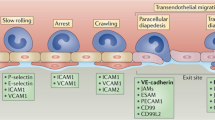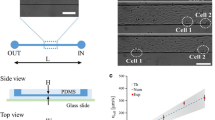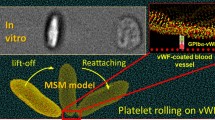Abstract
A multiscale Lagrangian particle solver introduced in our previous work is extended to model physiologically realistic near-wall cell dynamics. Three-dimensional simulation of particle trajectories is combined with realistic receptor–ligand adhesion behaviour to cover full cell interactions in the vicinity of the endothelium. The selected stochastic adhesion model, which is based on a Monte Carlo acceptance–rejection method, fits in our Lagrangian framework and does not compromise performance. Additionally, appropriate inflow/outflow boundary conditions are implemented for our SPH solver to enable realistic pulsatile flow simulation. The model is tested against in-vitro data from a 3D geometry with a stenosis and sudden expansion. In both steady and pulsatile flow conditions, results show close agreement with the experimental ones. Furthermore we demonstrate, in agreement with experimental observations, that haemodynamics alone does not account for adhesion of white blood cells, in this case U937 monocytic human cells. Our findings suggest that the current framework is fully capable of modelling cell dynamics in large arteries in a realistic and efficient manner.














Similar content being viewed by others
References
Alón R, Hammer DA, Springer TA (1995) Lifetime of the P-selectin-carbohydrate bond and its response to tensile force in hydrodynamic flow. Nature 374(6522):539–542
Asakura T, Karino T (1990) Flow patterns and spatial distribution of atherosclerotic lesions in human coronary arteries. Circ Res 66(4):1045–1066
Batchelor GK (1967) An introduction to fluid mechanics. Cambridge University Press, Cambridge
Bell GI (1978) Models for the specific adhesion of cells to cells. Science 200(4342):618
Bell GI, Dembo M, Bongrand P (1984) Cell adhesion. Competition between nonspecific repulsion and specific bonding. Biophys J 45(6):1051–1064
Bian X, Litvinov S, Qian R, Ellero M, Adams NA (2012) Multiscale modeling of particle in suspension with smoothed dissipative particle dynamics. Phys Fluids 24:012002
Blankenberg S, Barbaux S, Tiret L (2003) Adhesion molecules and atherosclerosis. Atherosclerosis 170(2):191–203
Buchanan JR, Kleinstreuer C, Hyun S, Truskey GA (2003) Hemodynamics simulation and identification of susceptible sites of atherosclerotic lesion formation in a model abdominal aorta. J Biomech 36(8):1185–1196
Caro CG, Fitz-Gerald JM, Schroter RC (1971) Atheroma and arterial wall shear observation, correlation and proposal of a shear dependent mass transfer mechanism for atherogenesis. Proc R Soc Lond B Biol Sci 177(1046):109–133
Chen Y, Girdhar G, Shao J-Y (2007) Single membrane tether extraction from adult and neonatal dermal microvascular endothelial cells. Am J Physiol Cell Physiol 292(4):C1272–C1279
Chesla SE, Selvaraj P, Zhu C (1998) Measuring two-dimensional receptor–ligand binding kinetics by micropipette. Biophys J 75(3):1553–1572
Chiu J-J, Chien S (2011) Effects of disturbed flow on vascular endothelium: pathophysiological basis and clinical perspectives. Physiol Rev 91(1):327–387
Chiu J-J, Usami S, Chien S (2009) Vascular endothelial responses to altered shear stress: pathologic implications for atherosclerosis. Ann Med 41(1):19–28
Chiu JJ, Chen CN, Lee PL, Yang CT, Chuang HS, Chien S, Usami S (2003) Analysis of the effect of disturbed flow on monocytic adhesion to endothelial cells. J Biomech 36(12):1883–1895
Comerford A, David T (2008) Computer model of nucleotide transport in a realistic porcine aortic trifurcation. Ann Biomed Eng 36(7):1175–1187
Cox RG, Brenner H (1967) The slow motion of a sphere through a viscous fluid towards a plane surface—II small gap widths, including inertial effects. Chem Eng Sci 22(12):1753–1777
Cybulsky MI, Gimbrone MA (1991) Endothelial expression of a mononuclear leukocyte adhesion molecule during atherogenesis. Science 251(4995):788–791
De Fabritiis G, Delgado-Buscalioni R, Coveney PV (2006) Multiscale modeling of liquids with molecular specificity. Phys Rev Lett 97(13):134501
Delgado-Buscalioni R, Coveney PV (2003) Continuum-particle hybrid coupling for mass, momentum, and energy transfers in unsteady fluid flow. Phys Rev E 67(4):046704
Delgado-Buscalioni R, Dejoan A (2008) Nonreflecting boundaries for ultrasound in fluctuating hydrodynamics of open systems. Phys Rev E 78(4):046708
Dembo M (1994) On peeling an adherent cell from a surface. Lect Math Life Sci 24:51–77
Dong C, Cao J, Struble EJ, Lipowsky HH (1999) Mechanics of leukocyte deformation and adhesion to endothelium in shear flow. Ann Biomed Eng 27(3):298–312
Ellero M, Adams NA (2011) SPH simulations of flow around a periodic array of cylinders confined in a channel. Int J Numer Methods Eng 86(8):1027–1040
Ellero M, Tanner RI (2005) SPH simulations of transient viscoelastic flows at low reynolds number. J Non-Newton Fluid Mech 132(1–3):61–72. ISSN: 0377-0257
Ellero M, Espanol P, Flekkøy EG (2003) Thermodynamically consistent fluid particle model for viscoelastic flows. Phys Rev E 68(4):041504
Espanol P, Revenga M (2003) Smoothed dissipative particle dynamics. Phys Rev E Stat Nonlin Soft Matter Phys 67(2 Pt 2):026705
Ethier CR, Simmons CA (2007) Introductory biomechanics: from cells to organisms. Cambridge University Press, Cambridge
Evans E, Berk D, Leung A (1991) Detachment of agglutinin-bonded red blood cells. I. Forces to rupture molecular-point attachments. Biophys J 59(4):838–848
Fedosov DA, Gompper G (2014) White blood cell margination in microcirculation. Soft Matter 10(17):2961–2970
Fedosov DA, Karniadakis GE (2009) Triple-decker: interfacing atomistic–mesoscopic–continuum flow regimes. J Comput Phys 228(4):1157–1171
Florin E-L, Moy VT, Gaub HE (1994) Adhesion forces between individual ligand–receptor pairs. Science 264(5157):415–417
Gholami B, Comerford A, Ellero M (2014) A multiscale SPH particle model of the near-wall dynamics of leukocytes in flow. Int J Numer Methods Biomed Eng 30(1):83–102
Gimbrone MA Jr, Nagel T, Topper JN (1997) Biomechanical activation: an emerging paradigm in endothelial adhesion biology. J Clin Investig 99(8):1809
Gingold RA, Monaghan JJ (1977) Smoothed particle hydrodynamics-theory and application to non-spherical stars. Mon Not R Astron Soc 181:375–389
Glagov S, Zarins C, Giddens DP, Ku DN (1988) Hemodynamics and atherosclerosis. Insights and perspectives gained from studies of human arteries. Arch Pathol Lab Med 112(10):1018–1031
Goldman AJ, Cox RG, Brenner H (1967) Slow viscous motion of a sphere parallel to a plane wall—I motion through a quiescent fluid. Chem Eng Sci 22(4):637–651
Goldman AJ, Cox RG, Brenner H (1967) Slow viscous motion of a sphere parallel to a plane wall—II Couette flow. Chem Eng Sci 22(4):653–660
Goldsmith HL, Karino T (1977) Microscopic considerations: the motions of individual particles. Ann N Y Acad Sci 283(1):241–255
Hansson GK, Robertson AKL, Söderberg-Nauclér C (2006) Inflammation and atherosclerosis. Ann Rev Pathol: Mech Dis 1:297–329
Hinds MT, Park YJ, Jones SA, Giddens DP, Alevriadou BR (2001) Local hemodynamics affect monocytic cell adhesion to a three-dimensional flow model coated with E-selectin. J Biomech 34(1):95–103
Hossain SS, Hughes TJR, Decuzzi P (2014) Vascular deposition patterns for nanoparticles in an inflamed patient-specific arterial tree. Biomech Model Mechanobiol 13(3):585–597
Hu XY, Adams NA (2006) Angular-momentum conservative smoothed particle dynamics for incompressible viscous flows. Phys Fluids 18:101702
Hund SJ, Antaki JF (2009) An extended convection diffusion model for red blood cell-enhanced transport of thrombocytes and leukocytes. Phys Med Biol 54(20):6415
Khismatullin DB (2009) The cytoskeleton and deformability of white blood cells. Curr Top Membr 64:47–111
Khismatullin DB, Truskey GA (2005) Three-dimensional numerical simulation of receptor-mediated leukocyte adhesion to surfaces: effects of cell deformability and viscoelasticity. Phys Fluids 17(3):031505 (1994-present)
Kim M-C, Nam JH, Lee C-S (2006) Near-wall deposition probability of blood elements as a new hemodynamic wall parameter. Ann Biomed Eng 34(6):958–970
Koumoutsakos P (2005) Multiscale flow simulations using particles. Annu Rev Fluid Mech 37:457–487. ISSN: 0066-4189
Kumar A, Henriquez Rivera RG, Graham MD (2014) Flow-induced segregation in confined multicomponent suspensions: effects of particle size and rigidity. J Fluid Mech 738:423–462
Kunov MJ, Steinmass DA, Ethier CR (1996) Particle volumetric residence time calculations in arterial geometries. J Biomech Eng 118(2):158–164
Lastiwka M, Basa M, Quinlan NJ (2009) Permeable and non-reflecting boundary conditions in SPH. Int J Numer Methods Fluids 61(7):709–724
Lee S-W, Antiga L, Spence JD, Steinman DA (2008) Geometry of the carotid bifurcation predicts its exposure to disturbed flow. Stroke 39(8):2341–2347
Lei H, Fedosov DA, Karniadakis GE (2011) Time-dependent and outflow boundary conditions for dissipative particle dynamics. J Comput Phys. 230(10):3765–3779. ISSN: 0021-9991
Libby P, Ridker PM, Maseri A (2002) Inflammation and atherosclerosis. Circulation 105(9):1135–1143
Litvinov S, Ellero M, Hu X, Adams NA (2009) Self-diffusion coefficient in smoothed dissipative particle dynamics. J Chem Phys 130:021101
Longest PW (2002) Computational analyses of transient particle hemodynamics with applications to femoral bypass graft designs. PhD thesis, MAE Department, NC State University, Raleigh, NC
Longest PW, Kleinstreuer C (2003) Particle-hemodynamics modeling of the distal end-to-side femoral bypass: effects of graft caliber and graft-end cut. Med Eng Phys 25(10):843–858
Longest PW, Kleinstreuer C (2003) Comparison of blood particle deposition models for non-parallel flow domains. J Biomech 36(3):421–430. ISSN: 0021-9290
Longest PW, Kleinstreuer C, Truskey GA, Buchanan JR (2003) Relation between near-wall residence times of monocytes and early lesion growth in the rabbit aorto–celiac junction. Ann Biomed Eng 31(1):53–64
Longest PW, Kleinstreuer C, Buchanan JR (2004) Efficient computation of micro-particle dynamics including wall effects. Comput Fluids 33(4):577–601. ISSN: 0045-7930
Loth E (2000) Numerical approaches for motion of dispersed particles, droplets and bubbles. Prog Energy Combust Sci 26(3):161–223. ISSN: 0360-1285
Lucy LB (1977) A numerical approach to the testing of the fission hypothesis. Astron J 82:1013–1024. ISSN: 0004-6256
Lyczkowski RW, Alevriadou BR, Horner M, Panchal CB, Shroff SG (2009) Application of multiphase computational fluid dynamics to analyze monocyte adhesion. Ann Biomed Eng 37(8):1516–1533
Matas JP, Morris JF, Guazzelli E (2004) Inertial migration of rigid spherical particles in poiseuille flow. J Fluid Mech 515:171–195. ISSN: 1469-7645
McKinney VZ, Rinker KD, Truskey GA (2006) Normal and shear stresses influence the spatial distribution of intracellular adhesion molecule-1 expression in human umbilical vein endothelial cells exposed to sudden expansion flow. J Biomech 39(5):806–817
Monaghan JJ (1992) Smoothed particle hydrodynamics. Ann Rev Astron Astrophys 30:543–574
Monaghan JJ (1994) Simulating free surface flows with SPH. J Comput Phys 110(2):399–406
Moore KJ, Sheedy FJ, Fisher EA (2013) Macrophages in atherosclerosis: a dynamic balance. Nat Rev Immunol 13(10):709–721
Moore KL, Patel KD, Bruehl RE, Li F, Johnson DA, Lichenstein HS, Cummings RD, Bainton DF, McEver RP (1995) P-selectin glycoprotein ligand-1 mediates rolling of human neutrophils on P-selectin. J Cell Biol 128(4):661–671
Morris JP, Fox PJ, Zhu Y (1997) Modeling low reynolds number incompressible flows using SPH. J Comput Phys 136(1):214–226. ISSN: 0021-9991
Moyle KR, Antiga L, Steinman DA (2006) Inlet conditions for image-based CFD models of the carotid bifurcation: is it reasonable to assume fully developed flow? J Biomech Eng 128(3):371–379
Nerem RM, Cornhill JF (1980) The role of fluid mechanics in atherogenesis. J Biomech Eng 102(3):181–189
Nerem RM, Alexander RW, Chappell DC, Medford RM, Varner SE, Taylor WR (1998) The study of the influence of flow on vascular endothelial biology. Am J Med Sci 316(3):169–175
Norman KE, Moore KL, McEver RP, Ley K (1995) Leukocyte rolling in vivo is mediated by P-selectin glycoprotein ligand-1. Blood 86(12):4417–4421
Packard R, Libby P (2008) Inflammation in atherosclerosis: from vascular biology to biomarker discovery and risk prediction. Clin Chem 54(1):24–38
Park EY, Smith MJ, Stropp ES, Snapp KR, DiVietro JA, Walker WF, Schmidtke DW, Diamond SL, Lawrence MB (2002) Comparison of PSGL-1 microbead and neutrophil rolling: microvillus elongation stabilizes P-selectin bond clusters. Biophys J 82(4):1835–1847
Piper JW, Swerlick RA, Zhu C (1998) Determining force dependence of two-dimensional receptor–ligand binding affinity by centrifugation. Biophys J 74(1):492–513
Pritchard WF, Davies PF, Derafshi Z, Polacek DC, Tsao R, Dull RO, Jones SA, Giddens DP (1995) Effects of wall shear stress and fluid recirculation on the localization of circulating monocytes in a three-dimensional flow model. J Biomech 28(12):1459–1469
Ramachandran V, Williams M, Yago T, Schmidtke DW, McEver RP (2004) Dynamic alterations of membrane tethers stabilize leukocyte rolling on P-selectin. Proc Natl Acad Sci USA 101(37):13519–13524
Rinker KD, Prabhakar V, Truskey GA (2001) Effect of contact time and force on monocyte adhesion to vascular endothelium. Biophys J 80(4):1722–1732
Ross R (1999) Atherosclerosis? An inflammatory disease. N Engl J Med 340(2):115–126
Rouleau L, Copland IB, Tardif J-C, Mongrain R, Leask RL (2010) Neutrophil adhesion on endothelial cells in a novel asymmetric stenosis model: effect of wall shear stress gradients. Ann Biomed Eng 38(9):2791–2804
Saffman PG (1965) The lift on a small sphere in a slow shear flow. J Fluid Mech 22(02):385–400
Sazonov I, Yeo SY, Bevan RLT, Xie X, van Loon R, Nithiarasu P (2011) Modelling pipeline for subject-specific arterial blood flow—a review. Int J Numer Methods Biomed Eng 27(12):1868–1910
Segré G, Silberberg A (1962) Behaviour of macroscopic rigid spheres in Poiseuille flow part 2. Experimental results and interpretation. J Fluid Mech 14(01):136–157
Shahriari S, Kadem L, Rogers BD, Hassan I (2012) Smoothed particle hydrodynamics method applied to pulsatile flow inside a rigid two-dimensional model of left heart cavity. Int J Numer Methods Biomed Eng 28(11):1121–1143
Shao J-Y, Ting-Beall HP, Hochmuth RM (1998) Static and dynamic lengths of neutrophil microvilli. Proc Natl Acad Sci 95(12):6797–6802
Simon SI, Goldsmith HL (2002) Leukocyte adhesion dynamics in shear flow. Ann Biomed Eng 30(3):315–332
Skilbeck C, Westwood SM, Walker PG, David T, Nash GB (2001) Population of the vessel wall by leukocytes binding to P-selectin in a model of disturbed arterial flow. Arterioscler Thromb Vasc Biol 21(8):1294
Skilbeck CA, Walker PG, David T, Nash GB (2004) Disturbed flow promotes deposition of leucocytes from flowing whole blood in a model of a damaged vessel wall. Br J Haematol 126(3):418–427
Spillmann CM, Lomakina E, Waugh RE (2004) Neutrophil adhesive contact dependence on impingement force. Biophys J 87(6):4237–4245
Sundd P, Pospieszalska MK, Cheung LS, Konstantopoulos K, Ley K (2011) Biomechanics of leukocyte rolling. Biorheology 48(1):1–35
Tabas I, Williams KJ, Borén J (2007) Subendothelial lipoprotein retention as the initiating process in atherosclerosis update and therapeutic implications. Circulation 116(16):1832–1844
Tambasco M, Steinman DA (2002) On assessing the quality of particle tracking through computational fluid dynamic models. J Biomech Eng 124(2):166–175
Thomas JB, Antiga L, Che SL, Milner JS, Steinman DA, Spence JD, Rutt BK, Steinman DA (2005) Variation in the carotid bifurcation geometry of young versus older adults implications for geometric risk of atherosclerosis. Stroke 36(11):2450–2456
Vázquez-Quesada A, Ellero M (2012) SPH simulations of a viscoelastic flow around a periodic array of cylinders confined in a channel. J Non-Newton Fluid Mech 167–168:1–8
Vázquez-Quesada A, Ellero M, Español P (2009) Consistent scaling of thermal fluctuations in smoothed dissipative particle dynamics. J Chem Phys 130:034901
Zhao H, Shaqfeh ESG, Narsimhan V (2012) Shear-induced particle migration and margination in a cellular suspension. Phys Fluids 24(1):011902
Zhu C (2000) Kinetics and mechanics of cell adhesion. J Biomech 33(1):23–33. ISSN: 0021-9290
Author information
Authors and Affiliations
Corresponding author
Rights and permissions
About this article
Cite this article
Gholami, B., Comerford, A. & Ellero, M. SPH simulations of WBC adhesion to the endothelium: the role of haemodynamics and endothelial binding kinetics. Biomech Model Mechanobiol 14, 1317–1333 (2015). https://doi.org/10.1007/s10237-015-0676-y
Received:
Accepted:
Published:
Issue Date:
DOI: https://doi.org/10.1007/s10237-015-0676-y




